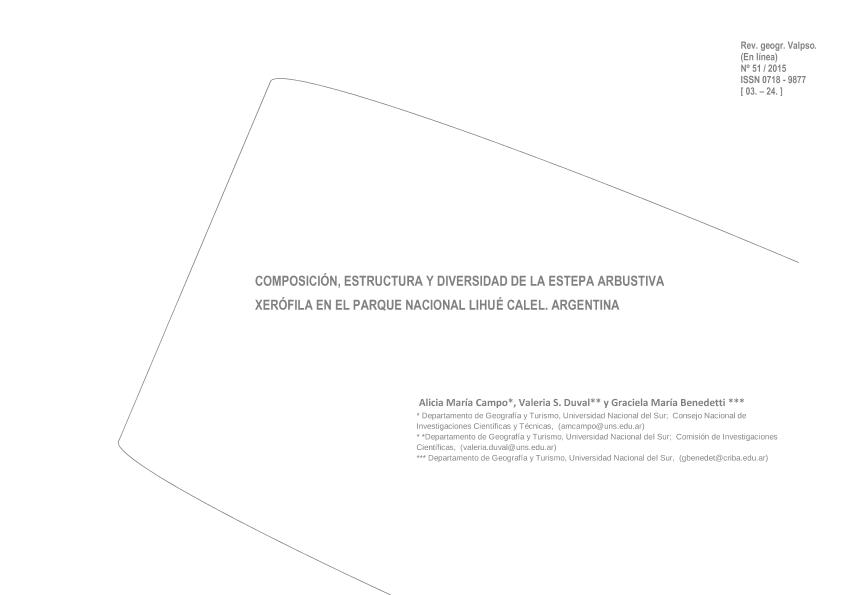Mostrar el registro sencillo del ítem
dc.contributor.author
Campo, Alicia María

dc.contributor.author
Duval, Valeria Soledad

dc.contributor.author
Benedetti, Graciela

dc.date.available
2018-05-28T20:02:53Z
dc.date.issued
2015-06
dc.identifier.citation
Campo, Alicia María; Duval, Valeria Soledad; Benedetti, Graciela; Composición, estructura y diversidad de la estepa arbustiva en el Parque Nacional Lihué Calel. Argentina; Pontificia Universidad Catolica de Valparaíso. Facultad de Ciencias del Mar y Geografía; Revista Geográfica de Valparaíso; 51; 6-2015; 3-24
dc.identifier.uri
http://hdl.handle.net/11336/46320
dc.description.abstract
El estudio de las formaciones vegetales incluye el análisis de la composición, estructura y diversidad de la vegetación. Mediante los inventarios se busca obtener la estructura vertical-horizontal, la fisonomía y la fenología de la flora así como explicar las causas de su distribución. El objetivo del trabajo fue analizar la composición, estructura y diversidad de la vegetación en un área protegida (Parque Nacional Lihué Calel) perteneciente a la estepa arbustiva xerófila. Para ello se aplicó la metodología de Cámaras Artigas denominado Muestreo en transecto de formaciones vegetales de fanerófitos y caméfitos (MIFC) y se representó mediante los diagramas de perfil de Pierre Dansereau. Para el análisis cuantitativo se utilizaron los índices de valor de importancia (I.V.I) e índices de diversidad alfa. Como resultado se relevaron 454 individuos vegetales pertenecientes a 23 especies y 11 familias. La cobertura muestra una distribución espacial semiabierta cuyo rango de altura más frecuente fue de 61 cm a 150 cm correspondiente al estrato arbustivo, de 30 cm a 60 cm del subarbóreo y de 151 cm a 350 cm perteneciente al arbustivo alto. El género vegetal que predomina es Larrea y la comunidad florística es el jarillal. A través del I.V.I se comprobó que la especie de mayor importancia fue Larrea divaricata. Los índices de diversidad alfa mostraron una diversidad media y estadísticamente una alta equidad en la muestra.
dc.description.abstract
The study of vegetation formations includes the analysis of the composition, structure and diversity. The inventories conducted allow to study the vertical and horizontal structure and the physiognomy and the phenology of plants and also to explain the causes of distribution. The objective was to analyze the composition, structure and diversity of vegetation in a protected area (Parque Nacional Lihué Calel) that belong to the xerophytic shrubland. Artigas Cameras’s methodology called “transect sampling of vegetation formations of phanerophytes and chamaephytes (MIFC)” was applied and then they were plotted using the profile diagrams of Pierre Dansereau. For quantitative analysis, the importance value index (I.V.I) and the alpha diversity indices were used. As a result 454 plants were surveyed that belong to 23 species and 11 families. The cover shows a half-open spatial distribution, and the height most frequently found was 61 cm to 150 cm for the shrub layer, 30 cm to 60 cm that correspond to subshrub layer and 151 cm to 350 cm belonging to high shrub. The floristic community is the jarillal with Larrea as the predominant genus. This was verified by the I.V.I index that showed that the most important species is Larrea divaricata. Statistically the Alpha diversity indices showed a high diversity and equity in the samples surveyed.
dc.format
application/pdf
dc.language.iso
spa
dc.publisher
Pontificia Universidad Catolica de Valparaíso. Facultad de Ciencias del Mar y Geografía
dc.rights
info:eu-repo/semantics/openAccess
dc.rights.uri
https://creativecommons.org/licenses/by-nc-sa/2.5/ar/
dc.subject
Estepa Arbustiva Xerófila
dc.subject
Mifc
dc.subject
Índice de Valor de Importancia
dc.subject
Índices de Diversidad Alfa
dc.subject.classification
Meteorología y Ciencias Atmosféricas

dc.subject.classification
Ciencias de la Tierra y relacionadas con el Medio Ambiente

dc.subject.classification
CIENCIAS NATURALES Y EXACTAS

dc.title
Composición, estructura y diversidad de la estepa arbustiva en el Parque Nacional Lihué Calel. Argentina
dc.type
info:eu-repo/semantics/article
dc.type
info:ar-repo/semantics/artículo
dc.type
info:eu-repo/semantics/publishedVersion
dc.date.updated
2018-04-26T15:07:28Z
dc.identifier.eissn
0718-9877
dc.journal.number
51
dc.journal.pagination
3-24
dc.journal.pais
Chile

dc.journal.ciudad
Valparaíso
dc.description.fil
Fil: Campo, Alicia María. Consejo Nacional de Investigaciones Científicas y Técnicas. Centro Científico Tecnológico Conicet - Bahía Blanca; Argentina. Universidad Nacional del Sur. Departamento de Geografía y Turismo; Argentina
dc.description.fil
Fil: Duval, Valeria Soledad. Consejo Nacional de Investigaciones Científicas y Técnicas. Centro Científico Tecnológico Conicet - Bahía Blanca; Argentina. Universidad Nacional del Sur. Departamento de Geografía y Turismo; Argentina. Provincia de Buenos Aires. Gobernación. Comisión de Investigaciones Científicas; Argentina
dc.description.fil
Fil: Benedetti, Graciela. Universidad Nacional del Sur. Departamento de Geografía y Turismo; Argentina
dc.journal.title
Revista Geográfica de Valparaíso
dc.relation.alternativeid
info:eu-repo/semantics/altIdentifier/url/http://www.pucv.cl/uuaa/geografia/revista/revista-n-51-2015/2018-03-16/172843.html
Archivos asociados
